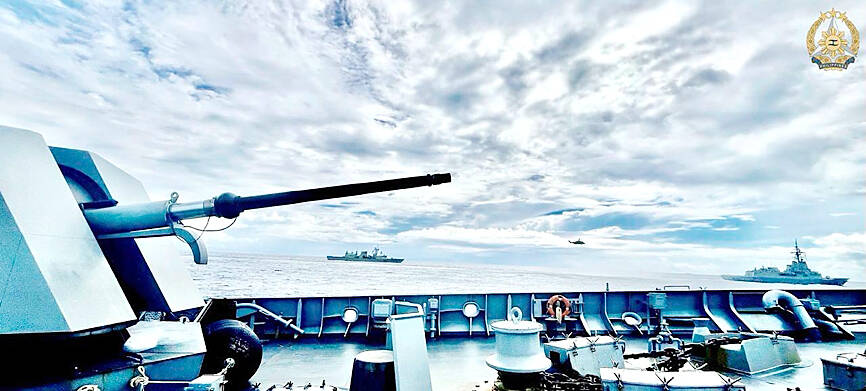Shanghai yesterday reopened a small part of the world’s longest subway system after some lines had been closed for almost two months, as the city paves the way for a more complete lifting of its painful COVID-19 lockdown next week.
With most residents not allowed to leave their homes and restrictions tightening in parts of China’s most populous city, commuters early yesterday needed strong reasons to travel.
Shanghai’s lockdown and curbs in other cities have battered consumption, industrial output and other sectors of the Chinese economy in recent months, prompting pledges of support from policymakers.
Many who ventured out in the commercial hub wore blue protective gowns and face shields. Inside the carriages, passengers were seen keeping some empty seats between themselves. Crowds were small.
Xu Jihua, a migrant construction worker, arrived at a subway stop before it opened at 7am, hoping to get to a rail station, then home to the eastern province of Anhui.
“Work stopped on March 16,” Xu said, adding that he had not been able to earn his monthly 7,000-to-8,000 yuan (US$1,046 to US$1,195) salary since then and would only return to Shanghai once he was sure he could find work.
Four of the 20 lines reopened, and 273 bus routes. Some had closed in late March, others later, although sporadic service continued with a limited number of stops.
The city of 25 million expects to lift its citywide lockdown and return to more normal life from Wednesday next week. Most restrictions on movement would remain in place this month.
Shanghai’s 800km metro system averaged 7.7 million rides a day in 2020, according to the latest data, with an annual passenger throughput of 2.8 billion.
Trains are to run 20 minutes apart for limited hours. Commuters must scan their body temperature at the entrance and show negative results of polymerase chain reaction (PCR) tests taken within 48 hours.
Shanghai has gradually reopened convenience stores and wholesale markets, and allowed more people to walk out of their homes, with community transmissions largely eliminated.
Still, parts of the city have recently tightened curbs, underlying the difficulty of resuming normal life under China’s “zero COVID-19” policy, which is increasingly at odds with the rest of the world.
Jingan, a key commercial district, said on Saturday it would require all shops to shut and residents to stay home until at least tomorrow, as it carries out mass testing.
The use of exit permits, previously given to residents that allowed them to leave their homes for short walks, will be suspended, authorities said without giving a reason.

Philippine President Ferdinand Marcos Jr has fired his national police chief, who gained attention for leading the separate arrests of former Philippine president Rodrigo Duterte on orders of the International Criminal Court and televangelist Apollo Carreon Quiboloy, who is on the FBI’s most-wanted list for alleged child sex trafficking. Philippine Executive Secretary Lucas Bersamin did not cite a reason for the removal of General Nicolas Torre as head of the 232,000-member national police force, a position he was appointed to by Marcos in May and which he would have held until 2027. He was replaced by another senior police general, Jose

STILL AFLOAT: Satellite images show that a Chinese ship damaged in a collision earlier this month was under repair on Hainan, but Beijing has not commented on the incident Australia, Canada and the Philippines on Wednesday deployed three warships and aircraft for drills against simulated aerial threats off a disputed South China Sea shoal where Chinese forces have used risky maneuvers to try to drive away Manila’s aircraft and ships. The Philippine military said the naval drills east of Scarborough Shoal (Huangyan Island, 黃岩島) were concluded safely, and it did not mention any encounter with China’s coast guard, navy or suspected militia ships, which have been closely guarding the uninhabited fishing atoll off northwestern Philippines for years. Chinese officials did not immediately issue any comment on the naval drills, but they

POWER CONFLICT: The US president threatened to deploy National Guards in Baltimore. US media reports said he is also planning to station troops in Chicago US President Donald Trump on Sunday threatened to deploy National Guard troops to yet another Democratic stronghold, the Maryland city of Baltimore, as he seeks to expand his crackdown on crime and immigration. The Republican’s latest online rant about an “out of control, crime-ridden” city comes as Democratic state leaders — including Maryland Governor Wes Moore — line up to berate Trump on a high-profile political stage. Trump this month deployed the National Guard to the streets of Washington, in a widely criticized show of force the president said amounts to a federal takeover of US capital policing. The Guard began carrying

Ukrainian drone attacks overnight on several Russian power and energy facilities forced capacity reduction at the Kursk Nuclear Power Plant and set a fuel export terminal in Ust-Luga on fire, Russian officials said yesterday. A drone attack on the Kursk nuclear plant, not far from the border with Ukraine, damaged an auxiliary transformer and led to 50 percent reduction in the operating capacity at unit three of the plant, the plant’s press service said. There were no injuries and a fire sparked by the attack was promptly extinguished, the plant said. Radiation levels at the site and in the surrounding